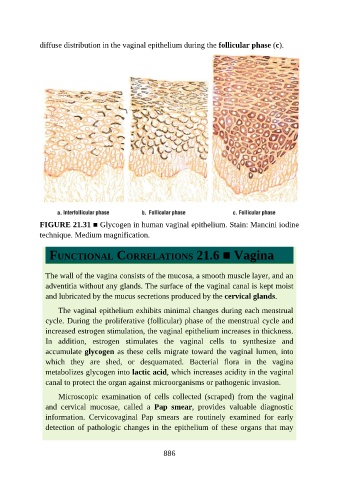Page 887 - Atlas of Histology with Functional Correlations
P. 887
diffuse distribution in the vaginal epithelium during the follicular phase (c).
FIGURE 21.31 ■ Glycogen in human vaginal epithelium. Stain: Mancini iodine
technique. Medium magnification.
FUNCTIONAL CORRELATIONS 21.6 ■ Vagina
The wall of the vagina consists of the mucosa, a smooth muscle layer, and an
adventitia without any glands. The surface of the vaginal canal is kept moist
and lubricated by the mucus secretions produced by the cervical glands.
The vaginal epithelium exhibits minimal changes during each menstrual
cycle. During the proliferative (follicular) phase of the menstrual cycle and
increased estrogen stimulation, the vaginal epithelium increases in thickness.
In addition, estrogen stimulates the vaginal cells to synthesize and
accumulate glycogen as these cells migrate toward the vaginal lumen, into
which they are shed, or desquamated. Bacterial flora in the vagina
metabolizes glycogen into lactic acid, which increases acidity in the vaginal
canal to protect the organ against microorganisms or pathogenic invasion.
Microscopic examination of cells collected (scraped) from the vaginal
and cervical mucosae, called a Pap smear, provides valuable diagnostic
information. Cervicovaginal Pap smears are routinely examined for early
detection of pathologic changes in the epithelium of these organs that may
886

